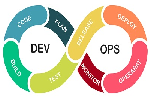AWS DevOps
What Is AWS?
If you go back a decade, the scenario of handling and storing data was different. Companies preferred storing data using their private servers. However, with more and better usage of the internet, the trend has seen a paradigm shift for companies, as they are moving their data to the cloud. This enables companies to focus more on core competencies and stop worrying about storing and computation.
For example, Netflix is a popular video streaming service which the whole world uses today. Back in 2008, Netflix suffered a major database corruption, and for three days their operations were halted. The problem was scaling up, which is when they realized the need for a highly reliable, horizontally scalable, distributed systems in the cloud. They began using cloud services, and since then their growth has been off the charts.
Gartner says that by 2020, a corporate “no-cloud” policy will be as rare as a “no-internet” policy today. Interesting, isn’t it?
Almost every company has started to adopt cloud services, and AWS, in particular, is the leading cloud service provider in the market. Let us understand more about it.
AWS
Amazon's AWS makes its customer base strong from small-scale companies to big enterprises like D-Link.
AWS DevOps
AWS is one of the best cloud service providers and DevOps is the popular and efficient implementation of the software development lifecycle, making AWS DevOps a highly popular amalgamation.

Why AWS for DevOps?

Get Started Fast
Each AWS service is ready to use if you have an AWS account. There is no setup required or software to install.

Fully Managed Services
These services can help you take advantage of AWS resources quicker. You can worry less about setting up, installing, and operating infrastructure on your own. This lets you focus on your core product.

Built for Scale
You can manage a single instance or scale to thousands using AWS services. These services help you make the most of flexible compute resources by simplifying provisioning, configuration, and scaling.
Programmable

You have the option to use each service via the AWS Command Line Interface or through APIs and SDKs. You can also model and provision AWS resources and your entire AWS infrastructure using declarative AWS CloudFormation templates.

Automation
AWS helps you use automation so you can build faster and more efficiently. Using AWS services, you can automate manual tasks or processes such as deployments, development & test workflows, container management, and configuration management.

Secure
Use AWS Identity and Access Management (IAM) to set user permissions and policies. This gives you granular control over who can access your resources and how they access those resources.

Partner Ecosystem
AWS supports a large ecosystem of partners which integrate with and extend AWS services. Use your preferred third-party and open source tools with AWS to build an end-to-end solution. Visit here to learn more about our DevOps Partner Solutions.

Pay-As-You-Go
With AWS purchase services as you need them and only for the period when you plan to use them. AWS pricing has no upfront fees, termination penalties, or long term contracts. The AWS Free Tier helps you get started with AWS. Visit the pricing pages of each service to learn more.

Software Release Workflows
AWS CodePipeline
AWS CodePipeline is a continuous integration and continuous delivery service for fast and reliable application and infrastructure updates. CodePipeline builds, tests, and deploys your code every time there is a code change, based on the release process models you define. This enables you to rapidly and reliably deliver features and updates.

Build and Test Code
AWS CodeBuild
AWS CodeBuild is a fully managed build service that compiles source code, runs tests, and produces software packages that are ready to deploy. With CodeBuild, you don’t need to provision, manage, and scale your own build servers. CodeBuild scales continuously and processes multiple builds concurrently, so your builds are not left waiting in a queue.

Deployment Automation
AWS CodeDeploy
AWS CodeDeploy automates code deployments to any instance, including Amazon EC2 instances and on-premises servers. AWS CodeDeploy makes it easier for you to rapidly release new features, helps you avoid downtime during application deployment, and handles the complexity of updating your applications.

Unified CI/CD Projects
AWS CodeStar
AWS CodeStar enables you to quickly develop, build, and deploy applications on AWS. AWS CodeStar provides a unified user interface, enabling you to easily manage your software development activities in one place. With AWS CodeStar, you can set up your entire continuous delivery toolchain in minutes, allowing you to start releasing code faster.
Microservices
Build and deploy a microservices architecture using containers or serverless computing.
Production Docker Platform
Amazon Elastic Container Service
Amazon Elastic Container Service (ECS) is a highly scalable, high performance container management service that supports Docker containers and allows you to easily run applications on a managed cluster of Amazon EC2 instances.

Serverless Computing
AWS Lambda
AWS Lambda lets you run code without provisioning or managing servers. With Lambda, you can run code for virtually any type of application or backend service - all with zero administration. Just upload your code and Lambda takes care of everything required to run and scale your code with high availability.
Coursera uses Amazon Elastic Container Service to manage a microservices -based architecture for its applications. Coursera can now deploy software changes in minutes instead of hours in a resource-isolated environment.
Localytics uses AWS Lambda to create microservices that ingest Amazon Simple Storage Service files and Kinesis data streams comprising about 100 billion data points each month.
________________________________________
Infrastructure as Code
Provision, configure, and manage your AWS infrastructure resources using code and templates. Monitor and enforce infrastructure compliance.

Templated Infrastructure Provisioning
AWS CloudFormation
AWS CloudFormation gives developers and systems administrators an easy way to create and manage a collection of related AWS resources, provisioning and updating them in an orderly and predictable fashion. You can use AWS CloudFormation’s sample templates or create your own templates.

Chef Configuration Management
AWS OpsWorks
AWS OpsWorks is a configuration management service that uses Chef, an automation platform that treats server configurations as code. OpsWorks uses Chef to automate how servers are configured, deployed, and managed across your Amazon Elastic Compute Cloud (Amazon EC2) instances or on-premises compute environments. OpsWorks has two offerings, AWS OpsWorks for Chef Automate, and AWS OpsWorks Stacks.Simple built its online banking platform on AWS. Using AWS CloudFormation, Simple can automate processes that once took months to complete and focus on its customer service rather than managing IT infrastructure.
The Toronto Star is Canada’s largest online news site. By using AWS OpsWorks, the Star reduced deployment time for its content management application from 3 hours to 20 minutes, saving costs and boosting productivity.

Configuration Management
AWS Systems Manager
AWS Systems Manager is a management service that helps you automatically collect software inventory, apply OS patches, create system images, and configure Windows and Linux operating systems. These capabilities help you define and track system configurations, prevent drift, and maintain software compliance of your EC2 and on-premises configurations.

Policy as Code
AWS Config
AWS Config is a fully managed service that provides you with an AWS resource inventory, configuration history, and configuration change notifications to enable security and governance. Config Rules enables you to create rules that automatically check the configuration of AWS resources recorded by AWS Config.
Prezi uses AWS Config to track configuration changes to Prezi's AWS resources. AWS Config sends notifications whenever resources are created, modified, or deleted. Prezi uses AWS Config rules to govern provisioning and configuration of its resources in AWS.
Provision infrastructure from AWS CloudFormation templates, invoke AWS Systems Manager to track your software inventory or to configure your instances, and auto-remediate any configuration drifts with AWS Config.
________________________________________
Monitoring and Logging
Record logs and monitor application and infrastructure performance in near real-time.

Cloud and Network Monitoring
Amazon CloudWatch
Amazon CloudWatch is a monitoring service for AWS cloud resources and the applications you run on AWS. You can use Amazon CloudWatch to collect and track metrics, collect and monitor log files, set alarms, and automatically react to changes in your AWS resources.

Distributed Tracing
AWS X-Ray
AWS X-Ray helps developers analyze and debug production, distributed applications, such as those built using a microservices architecture. With X-Ray, you can understand how your application and its underlying services are performing to identify and troubleshoot the root cause of performance issues and errors.
The Globe and Mail is Canada’s most read newspaper with a national weekly digital readership of 4.7 million. It used Amazon CloudWatch to monitor the performance of its system and adopted a DevOps approach for infrastructure automation.

Activity & API Usage Tracking
AWS CloudTrail
AWS CloudTrail is a web service that records AWS API calls for your account and delivers log files to you. The recorded information includes the identity of the API caller, the time of the API call, the source IP address of the API caller, the request parameters, and the response elements returned by the AWS service.
Slack provides a messaging platform for unifying diverse communications services. Slack’s platform runs on AWS, leveraging a wide range of cloud services. The company uses AWS CloudTrail for monitoring logs related to Amazon EC2 instances.
________________________________________
Platform as a Service
Deploy web applications without needing to provision and manage the infrastructure and application stack.

Run and Manage Web Apps
AWS Elastic Beanstalk
AWS Elastic Beanstalk is an easy-to-use service for deploying and scaling web applications and services developed with Java, .NET, PHP, Node.js, Python, Ruby, Go, and Docker on familiar servers such as Apache, Nginx, Passenger, and IIS. You can simply upload your code and Elastic Beanstalk automatically handles the deployment, from capacity provisioning, load balancing, auto-scaling to application health monitoring. At the same time, you retain full control over the AWS resources powering your application and can access the underlying resources at any time.
Zillow migrated its image-processing and delivery system to AWS to solve performance issues and gain scalability. It uses Elastic Beanstalk to run a Python Imaging Library with custom code for its image processing work.
Rachio is the creator of the Smart Sprinkler Controller, a WiFi-based irrigation controller. Rachio uses AWS Elastic Beanstalk to deploy and manage its website, apps, and APIs.
________________________________________
Version Control
Host secure, highly scalable Git repositories in the cloud.
Private Git Hosting
AWS CodeCommit
AWS CodeCommit is a fully-managed source control service that makes it easy for companies to host secure and highly scalable private Git repositories. You can use CodeCommit to securely store anything from source code to binaries, and it works seamlessly with your existing Git tools.
Using AWS CodeCommit, Edmunds.com developers have a scalable, highly available source control service that reduces costs and simplifies administration.
The DevOps seminar will help you to learn DevOps from scracth to deep knowledge of various DevOps tools such as fallowing List.
Kubernetes.Learn Latest Technologies

DevOps

AWS

Python

Azure

G Cloud

Linux

Web Tech

Data Bases

Testing

Git

Ansible

Chef

Kubernetes

HTML

CSS

